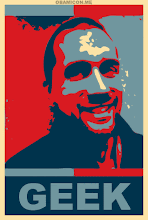Alana Meeker and Michele Stouffer represent Ford Motor Company, both Instructional Designers.
The fable of Re-Learning eLearning - How process and priduct changed to meet the needs of a specific project
Quick overview of the case study - Training on Finance Software to be delivered to a golbal audience of new and existing users. Five finance modules, plus an overview to be developed. Application training ONLY was demanded...as they put it, "no fluff".
One thing I noticed straight away when looking at their content was that it was very simple in its design and appearance - clean, nearly clinical. They use on-screen 'coaches', as they put it, that is a human face giving instruction, rather than a cold, hard text caption alone. Peoplesoft is used to develop their course shell, and Captivate is used to develop their simulation.
(Note - I will try to remain as objective as possible here, but, well...if you know me, you know what I do, and you know what I do it with (Captivate))
After developing the courses, they submitted their material to their 'masters' and they determined that anything aside from the actual application simulation was what they considered to be 'fluff'. Right away, I hold issue with this because you have to set up simulations...give the background, if you will. To launch someone straight away into a simulation is like jumping into an ice cold pool or hot bath...
Two issues were identified: Limited time and resources and Knowledge Transfer (SME to ISD, then ISD to developer). Here again, it seems like a major overstaff for what I'm looking at. Why couldn't the SME work directly with an ISD/Developer, especially considering the course was being developed in Captivate? Presenters identified aggressive timelines as an issue, but at this point I really don't see that...
Three problems identified that needed to be addressed before this conversion could be addressed. First, was a redesign of the course 'shell'. They were able to launch six courses from one page. (I'm still not quite on their page as to why this was such a herculean task?)
Secondly, they had to adapt their process to meet an aggressive timeline, and their solution was to adapt their current process to meet an aggressive timeline, which involves storyboarding and a simulation script. (Looking at the process, why so many steps?? I realize I'm very close to the content, but still...13 steps?) A great question came up - What is the difference between a storyboard and this separate "simulation script"? The presenter explained that they're different...but why?
Lastly, they had to design a new template for the revised process and a new shell, overall. Over four years, I've revised our process several times...When we develop, how we develop, how we get the SME involved, and so on. And, again, I fully recognize that there are separate difficulties associated with working alongside an external client. But this is not a huge task...deisgn your new process, submit it for approval, and implement.
So, as I understand it...January to June 15th, 10 staff members, 6 courses with 30-35 slides, on average, each. Maybe healthcare is just simpler content...but I don't know...
Summary/Conclusion
I realize I'm very close to this material, so I'm certainly much more opinionated than I normally would be, viewing a presentation, say, that I'm not ingrainedly familiar with. And, again, I understand that not only are our clients in house, but they're in house IT, so it's easy for them to work it in PowerPoint, then submit to us. That said, I just don't follow how any of this is rapid. From my standpoint, it all appeared pretty routine, if not lax in some of the timelines and/or staffing scenarios mentioned.
Subscribe to:
Post Comments (Atom)


No comments:
Post a Comment